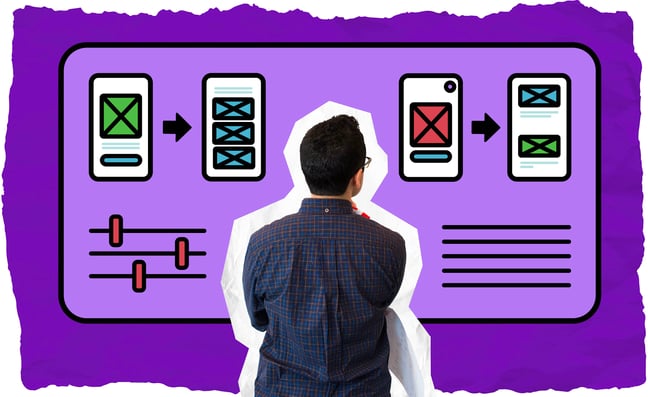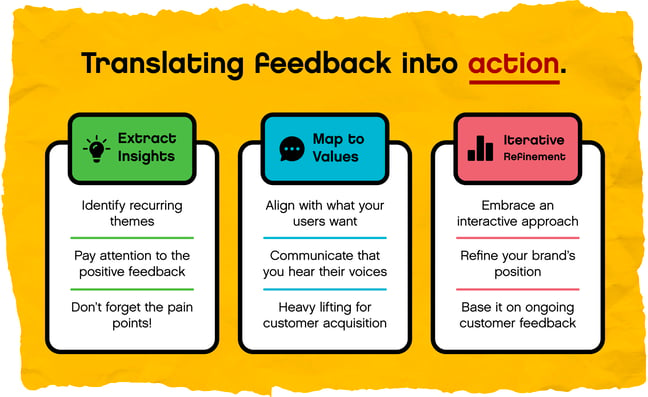How to Collect Customer Feedback And Use It To Craft Your Company Vision
Approx 7 min. read

"Le Client n'a jamais tort", which elegantly translates to "the customer is never wrong" is a quote by Cesar Ritz, a successful Swiss hotelier (hotel owner) from the 19th century. It stands as one of the earliest concepts in the world of customer service and business because it embodies a universal truth—that customer satisfaction and perspective hold maximum importance to the success of any business.
When someone asks 'How do you collect customer feedback?', it's easy to start thinking about surveys and emails but imagine this for a moment: a customer emails the support team of a SaaS startup, complaining about a bug in their software. After a little investigation, it becomes clear that the 'bug' wasn't in the product itself, but rather it occurred because of a flaw in the customer's integration process.
As unlikely as it may seem, this too is a form of feedback—a soft whisper from the customer that reveals a nugget of truth. And what truth is that? That the product's documentation may not be as simple and user-friendly as it should be.
Guided by this feedback, the startup may improve by providing clearer, more intuitive documentation that helps their users set up their product better. If you are prioritizing customer feedback whether the comment is small or large, there are insights to glean from both. In the paragraphs that follow, we'll talk about more ways customer feedback can be important, how to collect them, and most importantly, how to shape your company's vision from them.
Why Customer Feedback Is Important
A few decades back, the only way companies could get feedback from their customers was through occasional mail, phone calls, word of mouth, or face-to-face interactions. In many ways, this was a slower and much limited feedback ecosystem.
While the speed and reach of the internet have definitely been a game changer, allowing us to break free from the constraints of traditional channels, it is the general advancements in technology that truly empower businesses to now get this feedback seamlessly.
But purely speaking of feedback, why is it important?

When you engage in an open dialogue with a loved one, it deepens your connection. It opens doors and creates space to learn, adjust, and ensure your bond remains strong. In business, customer feedback plays this same role. It's the necessary conversation that ensures your products and services resonate with your users.
Technological advancements (and the internet) now enable businesses to collect feedback in ways unimaginable just a few decades back. Here are 4 your business can leverage today.
Surveys
Imagine sitting down with an old friend over a cup of coffee, asking questions about what they've been up to, what they do, how they're living—these questions would help you understand their thoughts, see into their world, and relate to them better.

Well-crafted survey questions are like mystical glasses that allow you to see into the world of others. It allows you to gauge their satisfaction, understand their expectations, and discover areas that need improvement.
User Testing and Prototyping
User testing is about putting your product or service out there, watching how customers use it, and trying to see what they really like and don’t like about it. Prototyping, on the other hand, is making a sample version of a product and releasing it for users to try out.

Although slightly different, both user testing and prototyping help to improve your product or service by exposing it to real users. This allows you to look at their actions, reactions, and suggestions, and then with each iteration, improve.
This can be done either by conducting hands-on sessions where you oversee users interacting with your product in person, or by creating simple trial versions for them to explore.
Customer Interviews and Focus Groups
As humans, we crave connection. Not just to other humans, but to everything in our surroundings. This innate desire for connection is why brands primarily look to form bonds with their users. They use storytelling, a brand voice, and visual consistency to make the brand feel alive and human. People connect to people, not to a logo just on a website.
When it comes to collecting customer feedback, focus groups provide that unique setting that makes connecting flow freely. It's like hosting a lovely dinner party where everyone comes together to share perspectives.
The power of focus groups lies in their ability to generate a collective consciousness. Sessions provide a fertile ground for brainstorming, exploring possibilities, and sparking new ideas.
Social Media
The overwhelming majority of our population is on social media these days. From the baby boomers and millennials posting on Facebook to the new age Gen Z making a living off platforms like X, Instagram, TikTok, etc.
What better way is there to eavesdrop on your users' conversations, if not through social media?
The beauty of social media is it not only allows you to listen, but also to participate actively in the ongoing dialogue. Whether it's through the comment section or an inside community.
How to Ensure Authentic Feedback
Authenticity in the feedback you get is something you want to strive for because it lets you know the data you now have is genuine, credible, and useful. There are certain measures that help to achieve this.
Overcoming Politeness Bias
Politeness bias is the tendency to avoid giving negative feedback, even when it is warranted. In both personal and business relationships, this is very often an obstacle to genuine communication.
After analyzing 400,000 sets of questions and answers on StackExchange, researchers say customers sometimes hold back their honest feedback to spare a brand’s feelings.

But how can brands overcome this and encourage unfiltered feedback?
-
Show gratitude for honesty. Let your customers know you appreciate their honesty even if it is critical feedback.
-
Use anonymous channels because it allows the customers to freely share their thoughts without any fear of repercussions.
-
Use constructive feedback requests; for example, instead of asking, "What do you think of our product?" you could ask, "What aspects of our product do you believe need improvement?". Specificity helps.
-
Incentivizing; consider offering rewards or incentives for customers who take the time to provide feedback. Show them you appreciate their feedback and they’ll be more likely to give it next time.
Empathy and Active Listening
To truly understand your customers, you need to employ empathy and active listening. They help you hear beyond just their words and let you understand everything behind those words.
One way to encourage consistent authentic feedback time and time again is to make your customers feel heard and understood. Brands can do this by using feedback loops where customers see that their input leads to tangible improvements. When this happens, they’re more likely to give very honest feedback next time because now they know their feedback matters.
Utilizing Indirect Signals
Indirect signals come in many different shapes and forms. As a brand, you’d need an open mind to be able to pick up on them. Remember our story about the SaaS startup at the start of this blog?
Although indirect signals can be hard to pick up, there are a few things to do (or pay attention to) that can help uncover insights that might not be overtly stated in surveys.
Social media eavesdropping: As mentioned previously, keeping an eye on social media conversations or mentions related to your brand can be game-changing as customers sometimes share unfiltered opinions here.
A/B Testing: This, also known as split testing, is a method used in marketing and web development used to compare two versions of a webpage, email, or any other form of content to see which outperforms the other. Brands can use A/B testing to compare different versions of their products. By analyzing how users respond to each variant, they can uncover preferences and issues that may not be openly expressed in feedback.
Translating Feedback into Action
Once you have enough feedback, then comes the question of what you should do with it.
One of the most iconic stories about businesses taking their customers seriously and treating them with respect is the story of Netflix and how they beat competition to dominance in the early 2000s. And let’s take that for example. What did Netflix do after knowing what their customers wanted?

Their user base had a problem with DVDs and wanted instant access to content. Netflix transitioned to streaming as a response. The users had a problem with the pay-per-rental model. Netflix made their platform subscription-based. Sure, the added features they made as a response to the feedback data allowed them to satisfy their existing users but it also pulled a larger audience.
Because after satisfying their user, they knew what to reposition as in the market to acquire even more users.
Good customer feedback can help a company’s branding. But like all things, it must be done well. And here’s how.
Extract Insights from Feedback Data
Start by identifying recurring themes. Patterns don't lie, they say. The recurring themes are the signposts that point toward the things that actually matter to your customers. Pay attention to the positive feedback, and pay attention to the pain points. The pain points especially. They're the gems waiting to be polished into treasure.
Once you've identified these insights, you now have the foundation upon which you'll build a customer-centric approach that truly addresses your users' needs and desires.
Map to Values
For successful rebranding, you must align your product or service with what you now know to be true of what your users really want. This alignment bonds the already present user base better because it communicates that you hear their voices and share their values.
It also does a lot of heavy lifting for customer acquisition. Why? Because you know what the market wants and you have positioned yourself in the market as the one who can give it to them.
Iterative Refinement
Building on that alignment, it’s necessary to know that the business world moves like a tidal wave. Everything swims swiftly, everything happens fast. In such a world, standing still is akin to moving backward. This is why it is necessary to embrace an iterative approach to refining your brand’s position (and quality of product) based on ongoing customer feedback loops.
In The Martian, a 2015 movie about a man lost on Mars, Mark Watney in the closing scene begins to talk about how he survived by regularly iterating his solutions to the several problems Mars threw at him. "You just begin. You solve one problem, and then the next one. And then the next. And if you solve enough problems, you get to come home.", he said.
This strategy not only helps in knowing what your brand stands for but also in ensuring you don’t stray from it after it’s set. Successful brands know how and how often to take a backseat and just remap everything. Are we still on track? Have we strayed from our path? How’s the company vision looking?
Wrapping up
The world moves fast. The business world moves even faster. Customer expectations from brands are much higher than what they used to be. That makes collecting customer feedback essential for any business that wants to consistently meet those expectations.
This blog post talks about how you can help your business get those feedback. It’s a roadmap, with every paragraph its own signpost by the roadside.
If you’re looking for more than just guidance; if you’re looking for a dedicated growth partner to not only help you gather feedback but also elevate your feedback experience and to redefine your idea of branding, then connect with us at EverWonder.
Related posts
Food for thought.
.jpg)
AI & The Customer Journey: Insights from HubSpot's Inbound 2023 Conference
by Patrick Gallant
.jpg)
Collective Consciousness
by Gabriella Cane